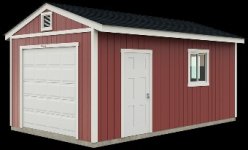If you are serious about cues and wood, it will be necessary to arrange the wood storage and the hanging area to be year round climate controlled AFA humidity. Insulation and weather seal are important whether you live (maybe especially if you live) in a warm climate with humidity or not. If you live in a dry climate year round, it might even be necessary to re-humidify if your products are mostly shipped to other areas.
Many cuemakers who did not arrive to that position from the hardwood lumber world buy "turning blanks" for stock. Because it is the economical way to acquire small quantities of exotics. The problem with "turning blanks" is that there is no requirement or specification for dryness at point of sale. Most are not dry, because the reason the vendor cuts them up into turning blanks is that they are trim from better boards, cut up boards that would not make grade otherwise, or just hardwood that tends to crack as it dries in large boards. That way the customer takes the risk as it dries.
However, for that reason, most cue makers have to go through long periods of drying and "seasoning". If the shop has no humidity control, that process can be long and unpredictable. It might not even happen. Conversely, if you do enter dry wood into your facility & the facility is in a humid area where relative humidity is often/usually above 50%; the dry wood can gradually pick up moisture the longer it is hung, to the point it might be too high to ship to a temperate region.

